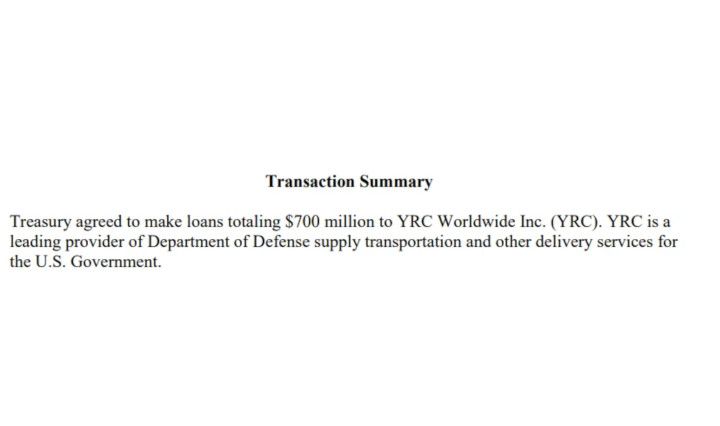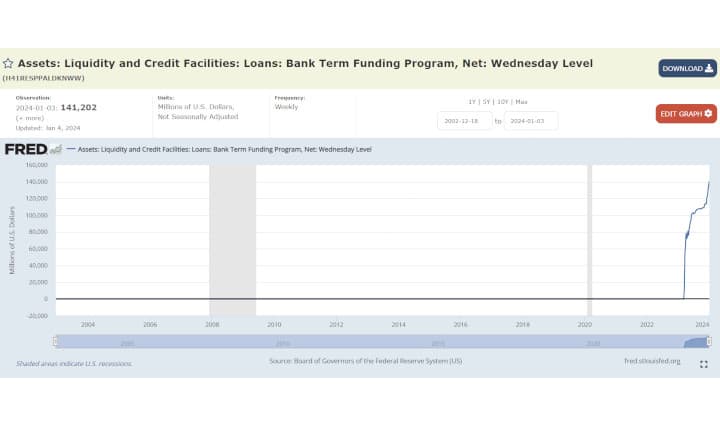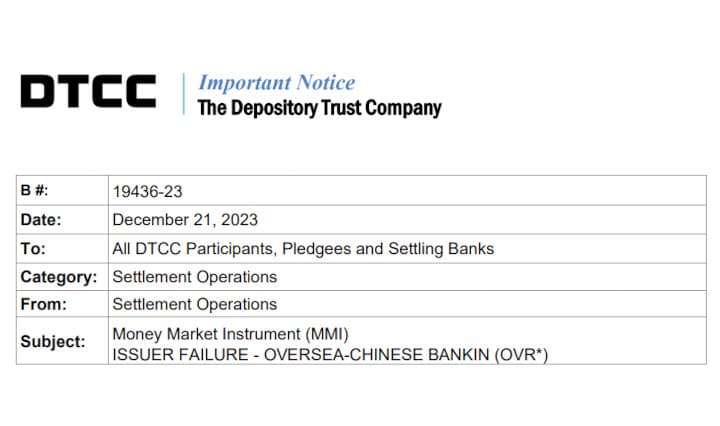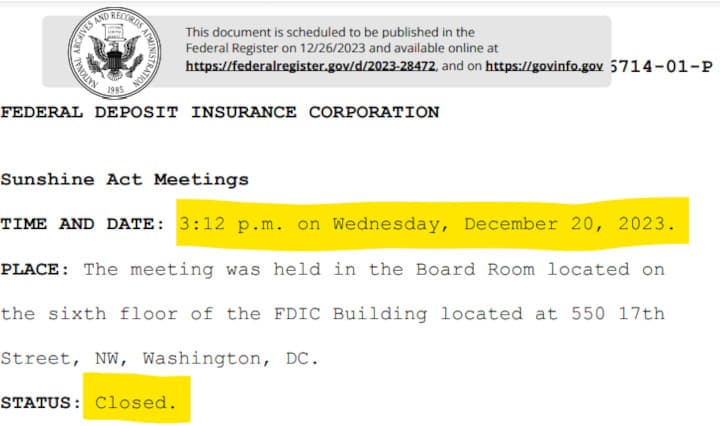Congressman French Hill on Treasury's previous $700 million bailout of Yellow: “I think the Treasury is undercollateralized. I’ll leave it at that” Treasury owns 15.94 million shares.

Is this pandemic emergency program blowing up a sign of things to come with BTFP & the collateral it accepts at PAR?
Good evening, it looks like Treasury is about to be caught holding the bag on pandemic loans, could there be implications for BTFP? Let's dig in!
“I think the Treasury is undercollateralized. I’ll leave it at that,”
“Unfortunately for the Treasury, I am afraid that their A tranche is in the third lien position behind the senior creditors,”
“They do have the additional support of their warrant for the company’s common stock, but I don’t know if that will end up having any value.”
What is the Congressman talking about?:


- The loan was broken up into two tranches, with the $300 million tranche A dedicated to YRC’s “near-term contractual obligations and non-vehicle capital expenditures.”
- Tranche B provided “$400 million for capital investments made pursuant to capital plans subject to approval by Treasury,” the summary said, noting that both tranches mature on Sept. 30, 2024.
- As taxpayer compensation, the Treasury Department also received shares, equal to 29.6% of YRC’s common stock on a fully diluted basis, to be held in a voting trust. With its stake of 15.94 million shares, the U.S. Treasury is Yellow’s second-largest shareholder.




Bank Term Funding Program (BTFP):

| Date | Bank Term Funding Program (BTFP) | Up from 3/15, 1st week of program ($ billion) |
|---|---|---|
| 3/15 | $11.943 billion | $0 billion |
| 3/22 | $53.669 billion | $41.723 billion |
| 3/29 | $64.403 billion | $52.460 billion |
| 3/31 | $64.595 billion | $52.652 billion |
| 4/5 | $79.021 billion | $67.258 billion |
| 4/12 | $71.837 billion | $59.894 billion |
| 4/19 | $73.982 billion | $62.039 billion |
| 4/26 | $81.327 billion | $69.384 billion |
| 5/3 | $75.778 billion | $63.935 billion |
| 5/10 | $83.101 billion | $71.158 billion |
| 5/17 | $87.006 billion | $75.063 billion |
| 5/24 | $91.907 billion | $79.964 billion |
| 5/31 | $93.615 billion | $81.672 billion |
| 6/7 | $100.161 billion | $88.218 billion |
| 6/14 | $101.969 billion | $90.026 billion |
| 6/21 | $102.735 billion | $90.792 billion |
| 6/28 | $103.081 billion | $91.138 billion |
| 7/5 | $101.959 billion | $90.016 billion |
| 7/12 | $102.305 billion | $90.362 billion |
| 7/19 | $102.927 billion | $90.984 billion |
| 7/26 | $105.078 billion | $93.155 billion |
| 8/2 | $105.684 billion | $93.741 billion |
| 8/9 | $106.864 billion | $94.921 billion |

- Association, or credit union) or U.S. branch or agency of a foreign bank that is eligible for primary credit (see 12 CFR 201.4(a)) is eligible to borrow under the Program.
- Banks can borrow for up to one year, at a fixed rate for the term, pegged to the one-year overnight index swap rate plus 10 basis points.
- Banks have to post collateral (valued at par!).
- Any collateral has to be “owned by the borrower as of March 12, 2023."
- Eligible collateral includes any collateral eligible for purchase by the Federal Reserve Banks in open market operations.
Richard Ostrander (one of the architects of BTFP) spoke about it the other day:
When the Federal Reserve established the BTFP, the lawyers of the New York Fed played an important role in facilitating its rapid implementation. I was responsible for coordinating among my team of attorneys at the New York Fed and the Board of Governors to ensure that our actions complied with applicable statutes and regulations.
Over the weekend of March 11 and 12, the Fed designed the BTFP to support the stability of the broader financial system by providing a source of financing for banks with Treasury, Agency and other eligible holdings whose market value had significantly diminished given interest rate increases.
There was not enough time to set up special purpose vehicles as the Fed had done for some of the pandemic programs. The only way to have the program up and running so quickly was to leverage our discount window facilities.
As a result, we turned to Section 13(3) of the Federal Reserve Act, which authorizes specialized lending in unusual and exigent circumstances. The BTFP extends the maximum term of lending from the Section 10B limit of four months up to a special limit of one year. Additionally, unlike traditional discount window operations, the BTFP authorizes banks to borrow against eligible holdings up to their par value rather than their market value less a haircut
The Fed has created an emergency backstop program so that banks won’t have to sell assets into the market if customers pull deposits in search of more attractive yields for their savings....

Over the few weeks prior to the FDIC receivership announcements on March 10 and 12, the banking sector lost another approximately $450 billion. Throughout, the banking sector has offset the reduction in deposit funding with an increase in other forms of borrowing which has increased by $800 billion since the start of the tightening.
The right panel of the chart below summarizes the cumulative change in deposit funding by bank size category since the start of the tightening cycle through early March 2023 and then through the end of March. Until early March 2023, the decline in deposit funding lined up with bank size, consistent with the concentration of deposits in larger banks. Small banks lost no deposit funding prior to the events of late March. In terms of percentage decline, the outflows were roughly equal for regional, super-regional, and large banks at around 4 percent of total deposit funding:

The blue bar in the left panel above shows that the pattern changes following the run on SVB. The additional outflow is entirely concentrated in the segment of super-regional banks. In fact, most other size categories experience deposit inflows.
The right panel illustrates that outflows at super-regionals begin immediately after the failure of SVB and are mirrored by deposit inflows at large banks in the second week of March 2022.
Further, while deposit funding remains at a lower level throughout March for super-regional banks, the initially large inflows mostly reverse by the end of March. Notably, banks with less than $100 billion in assets were relatively unaffected.
However, during the most acute phase of banking stress in mid-March, other borrowings exceeded reductions in deposit balances, suggesting significant and widespread demand for precautionary liquidity. A substantial amount of liquidity was provided by the private markets, likely via the FHLB system, but primary credit and the Bank Term Funding Program (both summarized as Federal Reserve credit) were equally important.

- Large banks increased borrowing the most, which is in line with deposit outflows being strongest for larger banks before March 2023.
- During March 2023, both super-regional and large banks increase their borrowings, with most increases being centered in the super-regional banks that faced the largest deposit outflows.
- Note, however, that not all size categories face deposit outflows but that all except the small banks increase their other borrowings.
- This pattern suggests demand for precautionary liquidity buffers across the banking system, not just among the most affected institutions:

Wut Mean?
- Banks have been replacing deposit outflows with the borrowing we have covered above.
- 'Strong and resilient' indeed....
- It is starting to smell idiosyncratic all up in here:

To me, this is looking more and more like over-reliance on Central Bank Funding!
Oh yeah...
TLDRS:
- Congressman French Hill on Treasury's $700 million bailout loans to Yellow: “I think the Treasury is undercollateralized. I’ll leave it at that,”
- Treasury owns 15.94 million shares of this now bankrupt company.
- Bank Term Funding Program over $100B for the 10th week in a row ($106.864B) .
- "The updated guidance encourages depository institutions to incorporate the discount window as part of their contingency funding plans."
- The liquidity fairy is now ENCOURAGED?
- The FDIC noticed that some banks aren't correctly reporting the amount of deposits they have that aren't covered by federal insurance. Some banks mistakenly think that if a deposit is backed by assets (like collateral), it doesn't need to be reported as uninsured.
- This isn't right! The deposit's status doesn't change just because it has collateral.
- When banks incorrectly report uninsured deposits, it could create a perception in the market that these banks are more stable than they actually are.
- Banks that incorrectly report uninsured deposits might face liquidity challenges in extreme circumstances, where depositors simultaneously demand their funds.
- Reminder, while banks have the liquidity fairy, 'we' get the promise of 2 more rate hikes this year, Atlanta Fed President Raphael Bostic yet again enrichens himself inappropriately from his position.
- To fix one end of their mandate (price stability) from the inflation problem they created, the Fed will continue sacrificing employment (the other end of their mandate) to bolster price stability by continuing to raise interest rates--causing further stress to businesses and households.
- I believe inflation is the match that has been lit that will light the fuse of our rocket.
- Is this pandemic era emergency program blow up a sign of things to come with BTFP & the collateral it accepts at PAR?



